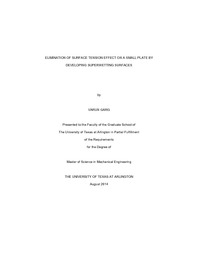| dc.description.abstract | In this work, we explored the possibility of creating superwetting surfaces, which are defined here as the ones with apparent contact angles less than 5°, using roughness structures for the purpose of eliminating surface tension effect on a floating small plate. It is often considered that the ratio of the actual roughness surface over the projected one plays a critical role in generating superwetting surfaces. However, we found that the ratio of the top surfaces of roughness structures over the projected one had more influence on apparent contact angles. As this ratio was less than 0.013, the resulting apparent contact angle might be less than 5°, when the intrinsic contact angle was 40° or above. Accordingly, hybrid micro/nanostructures, which had such a small ratio, were chosen to create the superwetting surfaces. These surfaces were subsequently applied to eliminate surface tension effect on a small plate. As a result of this elimination, the small plate that was denser than the liquid sank down to the liquid bottom. | |

